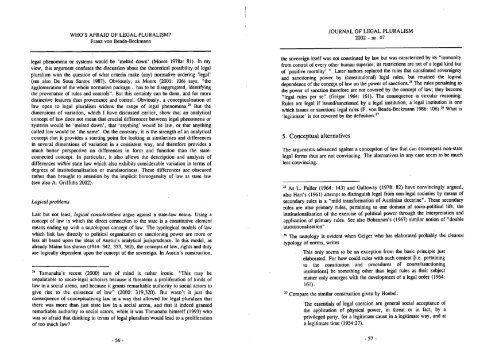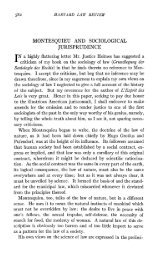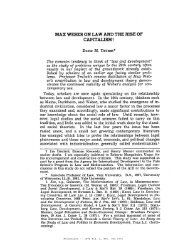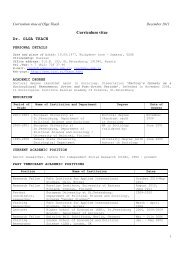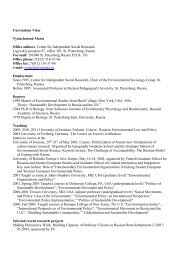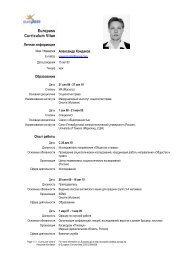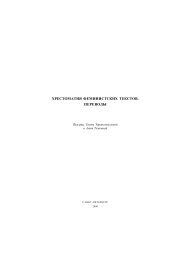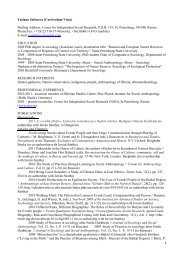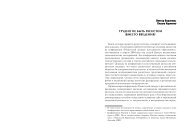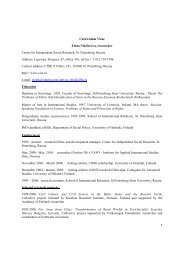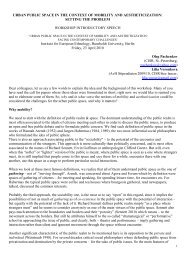who's afraid of legal pluralism?
who's afraid of legal pluralism?
who's afraid of legal pluralism?
You also want an ePaper? Increase the reach of your titles
YUMPU automatically turns print PDFs into web optimized ePapers that Google loves.
WHO'S AFRAID OF LEGAL PLURALlSM?Franz von Benda-BeckmannJOURNAL OF LEGAL PLURALISM2002 - ne. 47<strong>legal</strong> phenomena or systemswould be "melted down" (Moare 1978a: 81). In myview, this argument confuses the discussion about the theoretical possibility <strong>of</strong> <strong>legal</strong><strong>pluralism</strong> with the question <strong>of</strong> what criteria make (any) normative ordering '<strong>legal</strong>'(see also De Soua Santos 1987). Obviously, as Moore (2001: 106) says, "theagglomeration <strong>of</strong> Ihe whole normative package... has to be disaggregaled, idenlifyingIhe provenance <strong>of</strong> rules and controls". But Ihis cenainly can be done, and for moredislinclive features than provenance and contro\. Obviously, a conceplualisation <strong>of</strong>law open lO <strong>legal</strong> <strong>pluralism</strong> widens the range <strong>of</strong> <strong>legal</strong> phenomena. 24 BUI Ihedimensions <strong>of</strong> varialion, which I have discussed earlier, show that an analYlicalconcepl <strong>of</strong> law does not mean that crucial differences between <strong>legal</strong> phenomena orsystems would be 'melted down'. lhat 'anything' would be law, or Ihat anythingcalled law would be 'the same'. On Ihe contrary, it is the strenglh <strong>of</strong> an analyticalconcept that it provides a starting point for looking at similarities and differencesin several dimensions <strong>of</strong> varialion in a consislent way, and therefore provides amuch better perspeclive on differences in form and funclion Ihan Ihe stateconnectedconcept. In particular, il also allows the descriplion and analysis <strong>of</strong>differences within state law which also exhibits considerable variation in lerms <strong>of</strong>degrees <strong>of</strong> instilUlionalization or mandaloriness. These differences are obscuredrather Ihan broughl 10 attention by Ihe implicit homogeneily <strong>of</strong> law as state law(see a1so A. Griffnhs 2002).Logical problemsLasl but nol least, logical considerations argue againsl a state-Iaw nexus. Using aconcept <strong>of</strong> law in which the direct connection to the slate is a constitutive elemen!means ending up with a tautologous concept <strong>of</strong> law. The lypological models <strong>of</strong> lawwhich link law directly to political organization or sanctioning power are more orless all based upon the ideas <strong>of</strong> Austin's analytical jurisprudence. In this model, asalready Maine has shown (1914: 342, 353, 362), the concepls <strong>of</strong> law, rights and dutyare logically dependent upon the concept <strong>of</strong> the sovereign. In Austin's construction,24 Tamanaha's recent (2000) turn <strong>of</strong> mind is rather ironie. "This may beunpalatable lO socio-<strong>legal</strong> scholars because it threatens a proliferation <strong>of</strong> kinds <strong>of</strong>law in a social arena, and because it grants remarkable authority to social actors togive rise to the existence <strong>of</strong> law" (2000: 319,320). But wasn't it just theconsequence <strong>of</strong> conceptualising law in a way thal allowed for <strong>legal</strong> <strong>pluralism</strong> lhatthere was more than just slate law in a social arena, and that it indeed grantedremarkable authorily to social actors, whiJe it was Tamanaha himself (1993) whowas so <strong>afraid</strong> that lhinking in terms <strong>of</strong> <strong>legal</strong> <strong>pluralism</strong> would lead to a proliferation<strong>of</strong> too much law?- 56 the sovereign itself was nol constituted by law but was caracterized by its "immunityfrom control <strong>of</strong> every other human superior; its reslrictions are not <strong>of</strong> a <strong>legal</strong> kind but<strong>of</strong> 'positive moralily' ". Later authors replaced the rules that constituted sovereigntyand sanctioning power by (constitutional) <strong>legal</strong> rules, but retained lhe logicaldependence <strong>of</strong> lhe concept <strong>of</strong> law on the power <strong>of</strong> sanctions. 25 The rules pertaining tothe power <strong>of</strong> sanction lherefore are not covered by the concept <strong>of</strong> law; lhey become"<strong>legal</strong> rules per se" (Geiger 1964: 161). The consequence is circular reasoning:Rules are <strong>legal</strong> if issuedlsanctioned by a <strong>legal</strong> institution; a <strong>legal</strong> institution is onewhich issues or sanctions <strong>legal</strong> rules (F. von Benda-Beckmann 1986: 106).26 What is,legitimale' is not covered by lhe definition. 275. Conceptual alternativesThe arguments advanced against a conception <strong>of</strong> law thal can cncompass non-slate<strong>legal</strong> forms thus are not convincing. The alternatives in any case seem to be muchless convincing.2S As L. Fuller (1964: 143) and Galloway (1978: 82) have convincingly argued,also Hart's (1961) altempt to distinguish <strong>legal</strong> from non-<strong>legal</strong> societies by means <strong>of</strong>secondary rules is a "mild transformation <strong>of</strong> Austinian doctrine". These secondaryrules are also primary rules, pertaining to one domain <strong>of</strong> socio-political Iife, lheinstitutionalisation <strong>of</strong> Ihe exercise <strong>of</strong> political power through lhe interpretation andapplication <strong>of</strong> primary rules. See also Bohannan's (1967) similar notion <strong>of</strong> "doubleinstitutionalisation" .26 The tautology is evident when Geiger who has elaborated probably the c1earesttypology <strong>of</strong> norms, writesThis only seerns to be an exception from Ihe basic principie jusIelaborated. For how could rules with such content [i.e. penainingto the conslitution and procedures <strong>of</strong> courls/sanctioninginstitutions] be somelhing other than <strong>legal</strong> rules as their subjecImaller onIy emerges with lhe development <strong>of</strong> a <strong>legal</strong> order (1964:161).21 Compare lhe similar construction given by Hoebel:The essentials <strong>of</strong> <strong>legal</strong> ~oercion are general social acceptance <strong>of</strong>the application <strong>of</strong> physical power, in threat or in fact, by a'privileged party, for a legitimate cause in a legitimate way, and ala legitimate lime (1954:27).- 57


